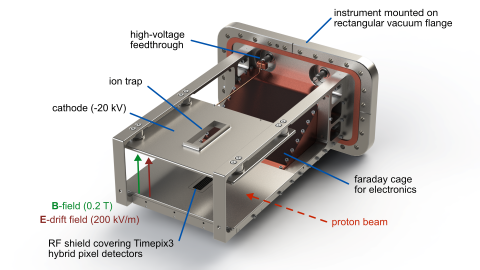
An important measurement in the CERN Proton Synchrotron (CPS) for beam diagnostics is the transverse emittance. A new instrument to perform these measurements has been developed using Timepix3 hybrid pixel detectors. The basic principle of the instrument is as follows: when a beam passes through the vacuum pipe it will ionize the residual gas and create negatively charged electrons and positively charged ions. By applying an external electric and magnetic field the electrons are accelerated down onto a detector, which in this case is the Timepix3, and based on the distribution of the electrons one can infer the profile of the beam.
The advantages of this solution compared to current instruments is that it provides continuous, non-destructive measurements and the time resolution available in the Timepix3 will facilitate bunch-by-bunch measurements of the beam profile [1].
Four Timepix3, with non-metallized silicon sensors, are mounted on a ceramic board side by side giving a transverse coverage of 56 mm. This board is mounted on a water-cooled copper plate and flexible cables connecting to the board provides the signal path to and from the pixel detectors through the vacuum flange. All of this is mounted inside the ultra-high vacuum (10^-9 mbar) of the CPS which requires the components to be tested beforehand to make sure they meet this stringent requirement [2]. As the system is located inside the tunnel of the CPS it is subjected to high radiation and electromagnetic fields that could cause disruptions to the electronics that are used to communicate with the pixel detectors. Therefore, a radiation-hardened readout system has been developed and successfully installed together with the detector.
In the summer of 2017 a first beam profile measurement was done using the instrument. Data was acquired during a 10 ms shutter window out of which 2 ms was chosen to allow comparison with a wire scanner measurement done at the same time. The data gives a Gaussian beam profile width of 1.22 ± 0.01 mm, which is in very good agreement with the expected beam size from the wire scanner measurement of 1.20 ± 0.01 mm at the same location [3].
Find out more: www.cern.ch/bgi-web/
References:
[1] J. W. Storey et al., “Development of an Ionization Profile Monitor Based on a Pixel Detector for the CERN Proton Synchrotron”, Proceedings of IBIC2015, TUPB059.
[2] S. Levasseur et al., “ Development of a rest gas ionisation profile monitor for the CERN Proton Synchrotron based on a Timepix3 pixel detector”, Journal of Instrumentation, vol. 12, no. 2, pp. 1-8, Feb. 2017, C02050.
[3] J. W. Storey et al., "First results from the operation of a rest gas ionisation profile monitor based on a hybrid pixel detector", (Submitted for publication)
